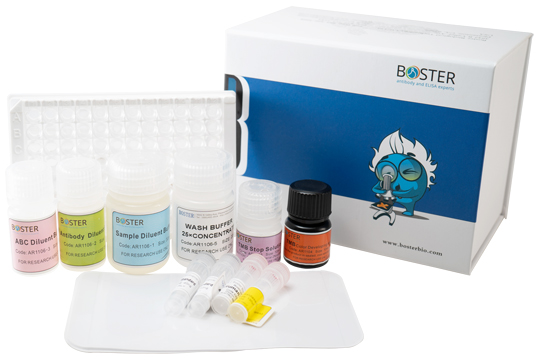This website uses cookies to ensure you get the best experience on our website.
- Table of Contents
Boster ELISA kits are always fully validated to ensure they meet high standards far beyond the industry recommendations. They are subjected to a thorough and rigorous process to guarantee excellent quality, performance, and reproducibility.
below are 6 main aspects we test for our ELISA kits before releasing each batch
Lot -to-lot consistancy
with reproducible results
Coefficient of variation for intra
and inter-assay precision.
Dilutions should always derive the same
final analyte concentration for a sample

Our kits are tested against related proteins to
ensure no cross-reactivity.
We test our kits over time with varying
protein concentrations
Low, medium, and high concentrations of recombinant human protein were used for spike and recovery experiments
Three samples with differing target protein concentrations were assayed using four different lots to measure the CV% variance. The typical data is obtained from Boster's internal QC result and for reference only. It may differ from the lab test results of the end users. It is more important that the user's lab test results reflect the same linearity demonstrated in the typical data than achieving exactly the same O.D. values.

Boster selectively evaluates the target analyte for the presence of other proteins in the typical testing samples and ensures no cross-reactivity. We look at homology with endogenous proteins, if there is any cross reactivity we will list it on the product page. The example below illustrates a group of proteins that have cross reactivity.

Boster spends great efforts in documenting lot to lot variability and make sure our assay kits produce robust data that are reproducible. Coefficient of variation for intra and inter-assay precision are usually less than 10%. Intra-Assay Precision (Precision within an assay): Three samples of known concentration were tested on one plate to assess intra-assay precision. Inter-Assay Precision (Precision across assays): Three samples of known concentration were tested in separate assays to assess inter-assay precision.

Boster ELISA kits are tested for stability. For instance, three samples with different concentrations of BDNF were assayed using the same lot of the Human BDNF ELISA kit over a 12 month period.
Dilutions should always derive the same final analyte concentration for a sample. This is known as assay linearity. Bosterbio performs dilution linearity to demonstrate that a sample with a spiked concentration can be diluted to
a concentration within the working range and still give a reliable result. We generate a dilution series using kit diluents across the dynamic range of the assay for each validated sample type. The results are expressed as a percent observed
from expected. Values between 80–120% show good assay linearity. To assess the linearity of the assay, four serum samples from healthy human containing or spiked with high concentrations of human BDNF recombinant proteins were serially
diluted to produce samples with values within the dynamic range of the assay.
The spiking recovery test, a method to evaluate the accuracy, was analyzed by adding a known amount of analyte to the sample matrices, such as serum and plasma. Recovery was calculated by comparing the observed concentration as
determined by ELISA and the expected concentration by summation. Low, medium, and high concentrations of analyte are spiked into all validated sample types and then analyzed for recovery. The results are expressed as a percentage of analyte
recovered. Our acceptance range for the recovery is 80–120%. Low, medium, and high concentrations of recombinant human BDNF were used as the spike in the spike and recovery experiments.
If you have any questions about our PicoKine ELISA kits please reach out to our support email or call us and we will provide you the information you need.
We take great pride in the art of antibody production. With over 25 years of experience in developing antibodies, we have established a comprehensive antibody development and validation system.
See MoreBosterbio provides a detailed ELISA principle, types of ELISA methods, and a comprehensive ELISA comparison. Learn the concept behind ELISA assay Today!
See MoreHuman MIA ELISA Kit PicoKine® (96 Tests). Quantitate Human MIA in cell culture supernatants, serum, plasma (heparin, EDTA) and saliva.. Sensitivity: 10pg/ml.
See MoreHuman CCL17/TARC ELISA Kit PicoKine® (96 Tests). Quantitate Human CCL17 in cell culture supernatants, cell lysates, serum and plasma (heparin, EDTA).. Sensitivity: 1pg/ml.
See MoreHuman PD-1 ELISA Kit PicoKine® (96 Tests). Quantitate Human PDCD1 in cell culture supernatants, serum and plasma (heparin).. Sensitivity: 10pg/ml.
See MoreHuman TAFI/CPB2 ELISA Kit PicoKine® (96 Tests). Quantitate Human CPB2 in cell culture supernatants, cell lysates, serum and plasma (heparin, EDTA).. Sensitivity: 15pg/ml.
See MoreHuman EGF ELISA Kit PicoKine® (96 Tests). Quantitate Human EGF in cell culture supernatants, serum, plasma (heparin, EDTA, citrate) and urine.. Sensitivity: 1pg/ml.
See MoreHuman COMP/Thrombospondin 5 ELISA Kit PicoKine® (96 Tests). Quantitate Human COMP in cell culture supernatants, cell lysates, serum and plasma (heparin, EDTA).. Sensitivity: 10pg/ml.
See More